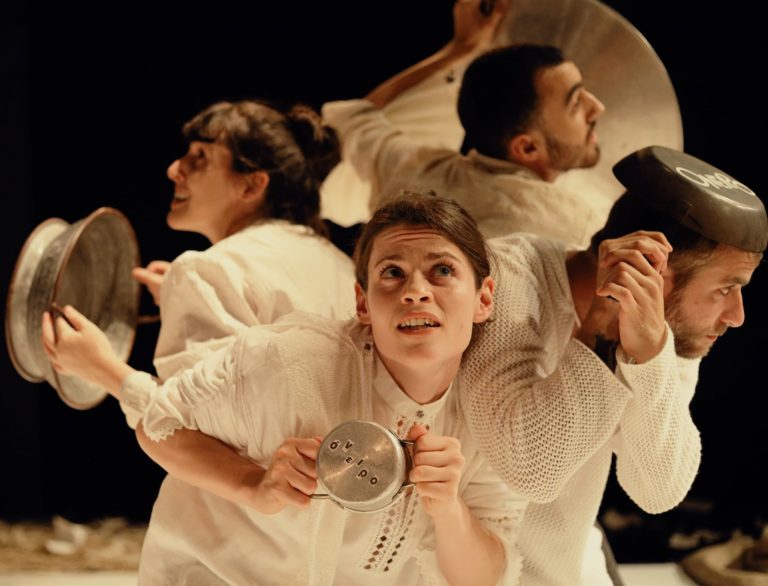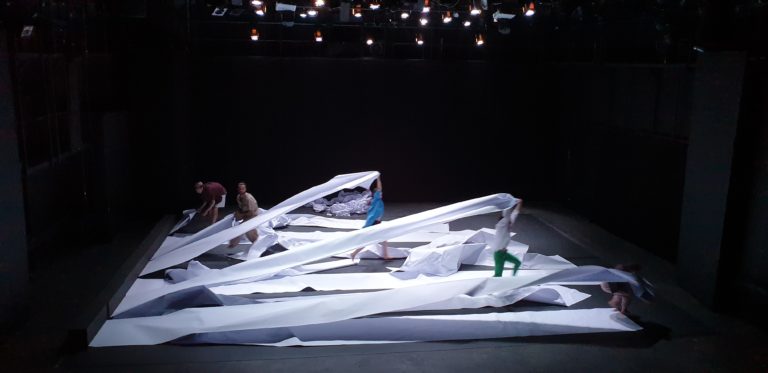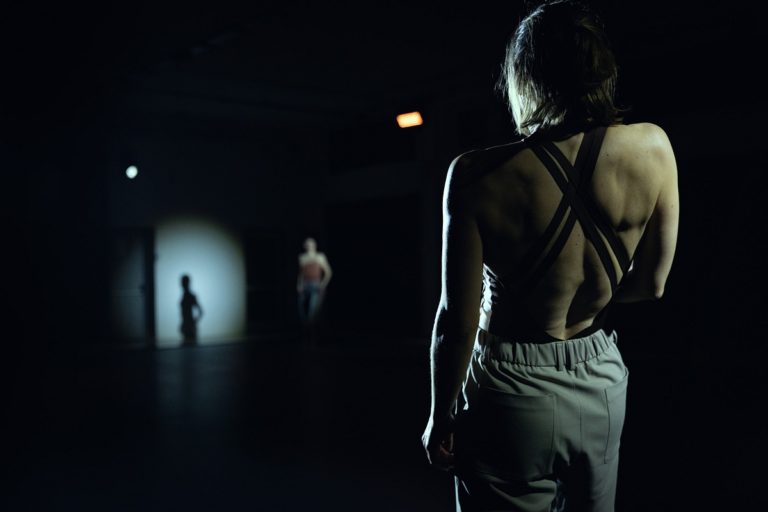Author: Maria Mantoukou
Surviving as an independent contemporary dance artist in Greece is a paradox of resilience and precarity. Despite the country’s deep cultural heritage and its historic role in shaping modern dance, today’s artists face systemic underfunding, limited institutional support, and the constant need to juggle multiple roles just to keep creating.

A Shield of Dreams, ArCT – © Xenia Tsilochristou
If you want to immerse yourself in an environment that will teach you what it takes to be an independent artist or collective[1], Greece is the place to be. Here you can witness first-hand how artists survive while creating art in a precarious environment.
Greece has a rich cultural history including architecture, theatre, or sculpture, but the country was also a major inspiration for Isadora Duncan, the pioneer of modern dance. It is logical to assume that a country with a cultural heritage intertwined with the arts, a heritage that inspired dance artists to create this form of dance, would be a thriving place for dance artists to live and create art. Unfortunately, this is not the case, at least in the field of contemporary dance.
The Ecology of the Greek Contemporary Dance Scene
The Greek contemporary dance scene as a field is considered an ecology due to its small size, non-hierarchical structure, and informal relationships between its members. This ecology is characterised by the lack of a robust cultural policy for dance, with support mainly limited to annual, short-term grants from the Greek Ministry of Culture, creating a void for large cultural corporations like Onassis Stagi to dominate the field, while obliging independent artists and collectives to become resourceful. These corporations with considerable financial and symbolic capital, offer grants and scholarships, and are actively involved in the production of contemporary dance works. There is also a plethora of independent and self-employed dance artists, collectives, non-profit organisations, and small-scale contemporary dance festivals created and led by dance artists. In this ecology, every independent artist is in a constant application race to secure funding for their artistic endeavours.
In the field of contemporary dance, being an independent artist is the norm, an inherent characteristic of working as a dance artist. Performing and choreographing is rarely a steady job, and having a contract with a dance company that performs regularly is also uncommon. Dance artists need to develop an autonomous work identity and ethic, which consists of holding multiple jobs inside and outside of the field (as dancers, choreographers, dance teachers, as well as working in flexible or seasonal jobs), while working on their own or others’ dance projects.
Since the financial crisis of 2009, Greece has faced more than 15 years of austerity, but the lack of funding for Greek dance artists goes back even further. There are no professional contemporary dance companies in Greece that employ artists on a long-term basis. Everyone works independently from project to project, provided they have secured funding. In addition, Greek society has never had a strong upper class with members who could act as patrons for the performing arts. As a result, Greek contemporary dance has been shaped solely by the individual motivation of dance artists–mostly women–who have created a path of independent artistic work.

IN(A)HABIT, Creo Dance Company - Polina Kremasta – © Andreas Skourtis
Difficulties and Peculiarities of Greek Contemporary Dance
There is much debate about the reasons for the lack of funding for dance. Firstly, the Greek dance scene originally developed close to the revival of ancient Greek theatre, from the 1940s to the 1980s, and gained some prestige. But it wasn’t until the 1990s that dance was able to stand on its own as a performing art. It was, and still is, a marginalised art.
Secondly, the perception of dance as an expression of sexuality and immorality is largely shared in Greek society, due to the conservatism that stems from Christianity. What’s more, the trivialisation of dance cannot be separated from prejudices, chauvinism, and social norms; it is a predominately female sport or profession, not only in Greece but worldwide.
Thirdly, Greece is no exception to the urbanisation of the arts, with contemporary dance performances taking place mainly in Athens. There are a few artist-run festivals in other cities or islands, as well as the state-funded Kalamata International Dance Festival. However, it is common for a dance company to have performed only in Athens, or abroad and in Athens, without reaching other parts of Greece.
Finally, Greece is the only European country without a university degree in dance and which does not recognise the degrees from foreign universities. Moreover, the 3-year programmes issued by the Ministry of Culture have been downgraded to the level of secondary education. Dance is also not a part of the school curriculum at any level. As a result, there is a dance illiteracy that influences both the public’s perception of contemporary dance and the size of the audience.

The Space Cadet, Third Planet – © Xenia Tsiloxhristou
Dance as a Subsidised Sector
Contemporary dance is a contemporary art form of an original, material, experimental, and ephemeral nature, prone to artistic trends, embracing diversity and abstraction. It is a difficult art form to understand for the average viewer, who may lack the tools to understand the language of the body, without language to articulate the artist’s message. Consequently, there is a feeling that it is incomprehensible, not only to the public, but also to the family or friends of the dance artists. Then, if we look at dance performance as a product—as it is unfortunately put upon us—, it is obvious that it is difficult to sell. People choose dance for sensory pleasure and the impact a work of art has on them. But in most cases, they don’t even know what the performance is about and whether they will like it or not. They make their choice based on certain expectations of its aesthetic and artistic value, shaped by word of mouth, the reputation and the symbolic and cultural capital of the choreographer, the dance company or the dancers involved.
Only large, well-established dance companies can produce multiple dance performances at a single venue or on tour and make profit from ticket sales. Most performances are short-lived, with the majority of income coming from grants. The audience is the recipient of the end performance, but contributes little or nothing financially through ticket sales. In a small country like Greece, the audience is mainly made up of people involved in dance, art, or education and is so small that the majority of the audience knows each other.
Taking all this into account, we can see the reasons why the field of independent contemporary dance production is a subsidy dependent economy.

APENANTI (ACROSS), Artemis Lampiri – © Pavlos Mavridis
“Hungry Bears Don’t Dance”
Being an independent artist and a collective in Greece is the only way to practice dance as a profession. So independent dance artists have developed some strategies to achieve this.
The main survival strategy is to take full responsibility for the whole production process, from the extensive application for funding, to the organisation of every aspect of the production process afterwards, to the adaptation to any form of funding (production, co-production, adaptation to smaller amounts than the original budget, personal grants for research projects, etc.). Independent artists are also responsible for their own networking, communication strategy and management, as well as investing their own money from other sources, such as other jobs or family money, into their projects. It is only in recent years that production and arts management companies have begun to take on dance projects from start to finish.
A second key aspect is the artists’ propensity for mobility and experience abroad. Many of the independent dance artists in Greece study dance abroad at undergraduate or, most often, postgraduate level. Most of them apply for funding (especially for EU projects) or to festivals and theatres to present their work. Some of them move to another country—usually European—to dance, choreograph, and practice their art. Mobility is a universally important characteristic of all artists and cultural workers, but for regional and financially struggling countries like Greece, working or studying abroad is seen as synonymous with success, adding to their cultural and social capital. Then it is no surprise that the existing problem of the Greek brain drain also applies to the arts and specifically to dance workers.
Another important survival strategy is to create either small festivals outside Athens, in their places of origin, or dance studios and art spaces in Athens. By doing so, they showcase their art, help other artists, gain autonomy, create an artistic legacy, and contribute to the cultural scene. Most of the festivals take place in the summer, taking advantage of the tourist season and the increased availability of participating artists. However, ensuring the long-term sustainability of these festivals or art spaces is a challenge. They are created and maintained through a large amount of personal—and mostly unpaid—work by artists and volunteers. Consequently, their success and sustainability depend on the symbolic capital and availability of the people who run them, combined with the sources of funding (subsidies or grants by private organisations), support and acceptance by the local community.
Thus, in the Greek case the above-mentioned oxymoron of the subsidised dance economy becomes more apparent; everyone involved (independent artists, collectives, producers, organisations, venues, and intermediaries) is dependent on subsidies. There is a Greek saying that loosely translates as “hungry bears don’t dance”, which means exactly this: if people’s basic needs aren’t met, they can’t be effective workers. Or can they?
[1] In Greece, artists must form a collective legal entity in order to apply for and receive State funding. This entity is a type of non-profit organisation called an 'A.M.K.E.' To be legal, an AMKE must be formed by at least two people. Through these legal entities, artists can apply for funding to produce their own work, either collectively or on a personal basis.
Published on September 30th, 2025
About the author:
Maria Mantoukou has studied ballet and contemporary dance, Media & Communications and has a master’s degree in Culture and Cultural Management. Based in Greece, she works as a dance educator, a freelance content writer/social media manager, and a cultural worker. This article is inspired by her master thesis at Panteion University of Athens entitled “Subsidies and funding as a tool of contemporary dance development”.